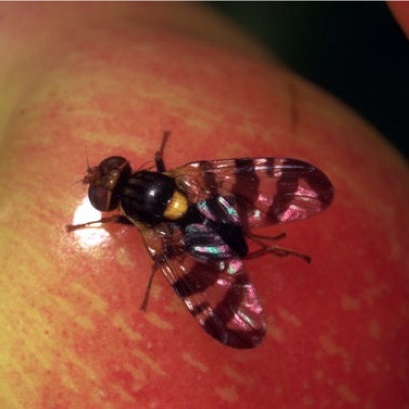Background
Rhagoletis cerasi (Linnaeus), also known as the European cherry fruit fly, is the most serious pest of cherries, Prunus spp., in Europe. It is currently regulated as a quarantine pest by Canada under the plant protection directive D-17-03: Phytosanitary requirements to prevent the introduction and spread of Rhagoletis cerasi (European cherry fruit fly), and is also regulated by the United States. Damage associated with this pest is caused by larval feeding in the fruit pulp, which can result in losses of up to 100% if left uncontrolled. This pest may be introduced to new areas with fresh cherries or with soil or fruit of host plants grown in areas where it occurs. The presence of this pest in Canada was confirmed for the first time in June 2016 in an urban park located in Mississauga, Ontario. This is the first record of this fly in North America. It was subsequently detected in New York State, US, (2017) and Quebec (2022). To date, R. cerasi has not been reported as a pest of concern in commercial cherry production in North America. Footnote 1 Footnote 2 Footnote 3 Footnote 4 Footnote 5 Footnote 6 Footnote 7
Plant pest card - European Cherry Fruit Fly
Identification
The adult is small, 3.5–4.0 mm long, and both males and females are predominantly black in colour. The wings are transparent, with characteristic dark crossbands. The base of the thorax (the scutellum) is entirely yellow, lacking a black basal mark (Figs. 1, 2). Rhagoletis cerasi can be distinguished from most other Rhagoletis species by the characteristic wing pattern and the distinctive yellow scutellum.
This species has three larval instars; the third larval instar is medium sized, 5–6 mm long and 1.2–1.5 mm wide, and white or yellowish in colour. The head (anterior end) has projecting and heavily sclerotized (hardened) mouth-hooks and the thoracic and abdominal segments have rows of spinules, including large anal lobes. The pupa is almost identical in appearance to the third larval instar, as the puparium is the hardened skin of this larval instar (Fig. 3). Footnote 1 Footnote 8 Footnote 9
Distribution
This species is currently found in:
- Asia: in temperate regions of Asia, including areas of the Middle East and Central Asia
- Canada: Ontario and Quebec
- Europe: most of Europe, except the United Kingdom
- United States: New York Footnote 1 Footnote 3 Footnote 4 Footnote 5 Footnote 6 Footnote 7 Footnote 13
Hosts
The main host plants of R. cerasi are species of cherry in the genus Prunus spp., including sweet cherry (P. avium), sour cherry (P. cerasus), black cherry (P. serotina) and mahaleb cherry (P. mahaleb). Honeysuckle plants (Lonicera spp.) are also hosts of this fly. Honeysuckle species documented as hosts in Europe are L. xylosteum, L. tartarica, and L. alpigena. In Canada, R. cerasi has been found on wild honeysuckle (Lonicera spp., including L. xbella, L. morrowii, and L. tartarica) and ornamental cherry (Prunus spp.) plants. Other known hosts reported by the US are species of barberry (Berberis spp.), common dogwood (Cornus sanguinea), common snowberry (Symphoricarpos albus), and coralberry (Symphoricarpos orbiculatus). To date, R. cerasi has not been reported as a pest of Lonicera caerulea (haskap) and has not been detected in association with commercial haskap production in Canada. However, further research is needed to definitively determine whether L. caerulea is also a host of this fly. Footnote 1 Footnote 2 Footnote 3 Footnote 6 Footnote 8 Footnote 9 Footnote 10
Biology
Rhagoletis cerasi has only 1 generation per year, with a long winter diapause during the pupal stage. The winter diapause usually lasts around 180 days but some pupae may remain dormant over 1, 2 or even 3 winters. Pupae overwinter in the soil, mainly underneath or near the host plant, and require temperatures of 7°C or lower to develop successfully. Adults emerge in the spring, usually appearing from May to July and have an average lifespan of 2 weeks. Females usually deposit 1 egg per fruit, beneath the skin of the fruit. Once larvae hatch from the eggs, they develop inside the fruit where they feed for up to 6 weeks. As the larvae develop, they damage the fruit pulp and contaminate the fruit with their feces, making infested fruit unacceptable for fresh consumption. Mature larvae exit the fruit through emergence holes and drop to the ground to burrow into the soil, generally at a depth of approximately 1 to 13 cm. Once in the soil, they will pupate within a few days. Footnote 1 Footnote 2 Footnote 4 Footnote 11 Footnote 12 Footnote 13
Signs and symptoms
This species only attacks the fruit of its host plants. The larvae are the harmful stage, as they develop inside the fruit and cause damage through larval feeding. Apart from damaging the fruit during egg laying, adults cause no other harm to the host plants.
Attacked cherry fruits are pitted with oviposition puncture marks and the tissue surrounding these punctures will appear soft and brownish. Brown rotten spots on cherry fruits may also be noticeable when the larva inside is fully grown. Exit holes are visible on cherries that larvae have vacated (Figs. 4, 5). Cutting into fruit may also reveal larvae and internal feeding damage, evident due to characteristic tunneling. Footnote 1 Footnote 3 Footnote 4
-
Figure 1 - Female adult on cherry.
Photo: Coutlin R. / OPIE
-
Figure 2 - Rhagoletis cerasi adults
Photo: Lund SD / www.biopix.com
-
Figure 3 - Rhagoletis cerasi pupae
Photo: Coutlin R. / OPIE
-
Figure 4 - Damage on cherry. Larva exiting the cherry fruit.
Photo: Coutlin R. / OPIE
-
Figure 5 - Damage on cherry. Larval exit holes.
Photo: Coutlin R. / OPIE